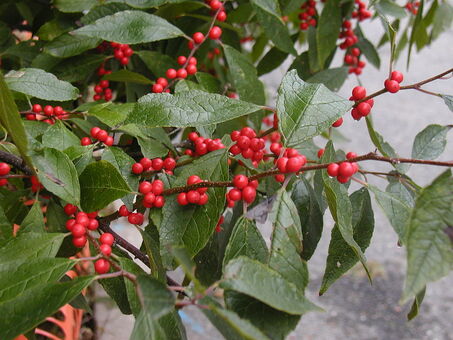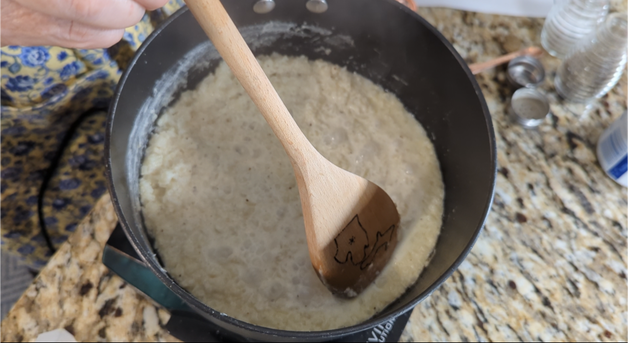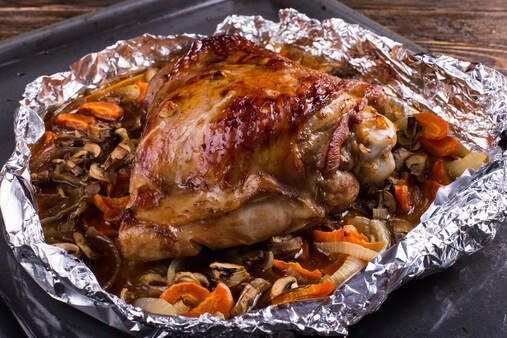|
Dinner Party Rule #1: Prepare Your Best Recipe!
Fresh out of college and living in my first solo apartment, I felt like a “real” grownup. I had stacks of stoneware dishes. I had matching silverware and glassware. I had placemats and tablecloths and candleholders. I had all this grownup dining paraphernalia because just a year earlier I’d been a runaway bride. But that’s a different story. I knew how to set a pretty table and make guests feel welcome. So why did I think I could just whip up anything on the stove? Why?? It was a third date, and I’d generously invited the new man in my life to a home-cooked meal. “Let’s do Chinese!” I blurted. He thought that was a great idea and said, “I love egg drop soup!” The smile froze on my face and we set a time for his arrival. And then I freaked out. Because I’d never attempted egg drop soup, had no time to perfect the dish, and didn’t want to fail at my first-ever, adult dinner party. So I did the only thing I could do: I called a college roommate and savvy cook for help. And this was the plan we devised: I’d tackle dressing the table and the beef stir-fry. She’d tackle the soup and fried rice. I bought the pre-made fortune cookies. When he arrived, she’d slip out the back whilst I answered the front doorbell. And the dinner went off exactly as planned. I wasn’t even sweating. And I learned a valuable lesson that night: Just offer and cook what you’re comfortable making. This would be a signature dish, like meatloaf or spaghetti or chicken pot pie or a crockpot stew. Don’t be fancy. Don’t be clever. Be comfortable with your meal, so your guests will be equally comfortable. Because, bonus tip: If you’re sweating when you answer the door, no one will want to eat your soup.
0 Comments
Sometimes we can struggle to buy gifts for the men in our lives, but there's really no need to over think it. When it comes to gifts for men, focus on your man’s hobbies and habits. For example:
Does he grill? It’s no secret men love meat and fire—often at the same time!—so grilling gifts are a win. Consider these options:
Is he artsy? If you know an artist, consider a word tree. Choose meaningful names of people, places and events from your relationship, and shape them into a tree on canvas. People form the roots, places shape the trunk, and branches show off events. Bonus: Use his favorite color for text or background, then frame it! Does he enjoy a good bourbon? Maybe he’s a wine connoisseur or beer snob. Indulge him with a year’s subscription to a bourbon- or wine- or beer-of-the month club! These options vary wildly in price, so treat him to what you can afford. Bonus: Present this monthly gift with a “flight” kit. That way, he’ll be ready to show off his collection with a group tasting! Have you ever looked around your living space and thought, ‘I’m so tired of this…’? It was probably just fine five years ago when you moved in or the kids were little or you were going through that orange phase. But now…meh. Or even…ick.
You know what you need? A redesign. Not a remodel—too expensive, too irritating and, possibly, too risky. A redesign leaves the walls, windows, electrical and floors right where they are. They just get a little “tweak.” For this concept, you’ll need a cohort in design. Do you have a friend whose living space always looks crisp, up-to-date, and in need of zero alteration? That’s the person you’ll want to ask for help. If you’re tired of your stale space, that friend is most certainly tired of it, too! In fact, this may be just the opportunity they’ve been waiting for. Once you’ve chosen the space (living room, master bedroom, office are great options) and you’ve lined up your redesign cohort, you’re ready for these next five steps: Step 1: Clear out everything from the room. Yes, everything—the furniture, the rugs, the drapes, any art or knickknacks on the walls. Every single part of that room should look like someone is about to move in. Because after this redesign, you will! Set aside any item you absolutely must have in that room—like family portraits, seating, and heirloom pieces. Everything else should be boxed up for storage or donation. You must, as that irritating song reminds us, “let it go.” Step 2: Clean, clean, clean. You want every surface—walls, baseboards, floors mantles—to be squeaky clean before you make another move. At this point, the space will look and smell so fresh you might just decide to set up a tent for some overnight glamping. Step 3: Paint. If your funds are extremely limited, paint just one wall. If you have a discount option near you (like Habitat for Humanity‘s Restore), you can often buy unopened surplus paint for a pittance. If you’re not dead set on a specific color, this option is for you. And then you can afford to paint every wall! Step 4: Release the space to your design cohort. And “release” in this scenario means you leave the house for a determined amount of time and cut your designer friend loose. This sounds risky, but a trusted friend knows your style and what you won’t accept or find outrageous. Bonus: Hand over $100 for your friend to use however they wish—window coverings, open shelving, paint, design bits and bobs. Provide no limitations on what this designer wants to do! Then go drown your nervousness in a cup of overpriced coffee. Go ahead and get the pastry. Step 5: Revel in the reveal! Yes, the reveal feels and looks just like those moments on TV. You walk in a little nervous about the space and squeal with joy when you see it all reimagined. You might actually be shocked with furniture and art placement. You’ll find yourself saying, over and over, “I never would have thought to do that!” Keep in mind: If you’re a bit of a knickknack hoarder, the new space might look a little empty. Live with it for a week before you add back some clutter. If the windows feel naked without drapes, try low-level lighting to soften the sudden brightness. If the furniture arrangement feels completely unfamiliar, use the room in different ways, for different purposes. Not only is a redesign affordable, it drags you out of a design rut. In as little as two days, you and your space can be refreshed and ready for the next adventure. Now, about that patio… So, you found the ideal home in a great neighborhood but…ohhhh…the kitchen is really small. And you have excellent culinary skills. And lots of cooking gear. What do you do now? You make it work with a lot of organization and some helpful products, like:
Tips for keeping pantry food fresh longerRemember that time you pulled out your trusty box of Bisquick to whip up dinner biscuits…and they didn’t rise? And company was on their way? I do. Turns out the yeast had expired in my mix—which had also expired. I thought that mix would last forever but—surprise!—it doesn’t. Its shelf life is decent, but the leavening and oil ingredients can, and did, deteriorate. Which begs the question: What other pantry staples have shorter shelf lives than you think? And how do you extend the usage time? Consider these:
5 ways to make your home more cozy and invitingSweater weather, fuzzy slippers, and snuggly blankets. Ahhh…. So delightfully…cozy. But how do you bring the “cozy” into your home? Try these tips:
Do's and Don't's of creating a winter gardenWith frosty nights killing off fall blooms, it’s time to consider your winter garden. Winter…what? Yes! You can enjoy an amazing garden in winter, as long as you focus on these five elements:
6 ways to clean wooden spoonsHave you taken stock of your wooden spoons lately? I mean, other than their legendary status as a spanking spoon—or just the threat of a bopping—they’re considered symbols of hospitality, and have remained kitchen staples since Ancient Egypt wasn’t exactly ancient yet.
Unlike metal spoons, the wooden utensil won’t scratch pans or bowls, won’t conduct heat and burn your hand or alter your cooking temps, are non-reactive with acidic foods, and won’t crack glass if you’re stirring a bit aggressively. On the flip side, wooden spoons can retain flavors—so that garlic pasta sauce you stirred last night might not go well with the cookie dough you’re mixing today. Now, if you’re being hospitable and using your wooden utensils properly and regularly, are you cleaning them appropriately? Let’s find out by exploring how your spoons want to survive your kitchen.
Wooden utensils are more than just kitchen essentials—they’re pretty, versatile, and are often passed down through generations of home chefs. Treat them well, and they’ll reward you with their can-do spirit. Congratulations! Thanksgiving was an enormous success, and all you have to do the next few days is… Find something to do with alllllllll those leftovers. Sure, sure, you can whip up the traditional turkey sandwich and chili, but consider some new options, like:
When was the last time you shaved, put on makeup or generally got ready for a day/night out in your guest bathroom? Did you have everything you needed? Was the lighting good? Did the shower drain? Or…was the toilet paper missing, lightbulbs burned out, and water standing in the tub? These are basic issues you need to check and resolve before any guest steps through your front door.
But if you want to be a SUPER host, you have a little more guest work to do to attain that title. Have your guest bathroom stocked with these items:
With just a little bit of pre-planning and stocking, you can help any guest prepare for a fun evening or weekend—your treat! And then you’ll wear that Super-Host hat proudly…right after you re-stock the toilet paper. |
Christine SchaubA Michigan farm girl transplanted to the South offering hospitality hacks. Categories
All
Archives
July 2024
Categories
All
|








 RSS Feed
RSS Feed
